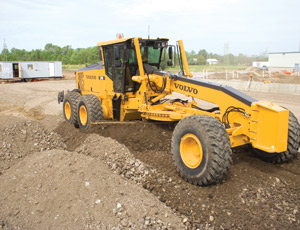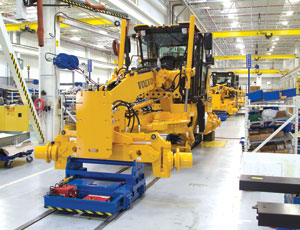Visitors who spend time in Volvo Construction Equipment’s 30,000-sq-ft booth during the upcoming CONEXPO-CON/AGG expo in Las Vegas will see 19 new pieces of construction equipment that collectively represent the company’s ambitious plans to expand in North America and abroad.


Many of those construction machines will come from Volvo CE’s newly expanded and streamlined factory in Shippensburg, Pa., which now produces more than 60 models of asphalt pavers, soil and asphalt compactors, screeds, milling machines and motor graders. The CONEXPO show will be held on March 22-26 and is thought to be the largest trade show in the Western Hemisphere.
Last fall, Volvo completed a two-year, $30-million expansion that grew the plant’s size by 53%, to 580,000 sq ft from 380,000 sq ft, and added a motor-grader test track as well as a compactor-vibration test pit. The upgrading also improved manufacturing efficiency. Volvo has moved all production of motor graders for the North American market from Goderich, Ontario, Canada, as well as cab manufacturing from Asheville, N.C., to Shippensburg.
Volvo acquired the Shippensburg plant in 2007 when it purchased the road-development division of Ingersoll-Rand. Goran Lindgren, president of Volvo Construction Equipment North America, says Volvo is basing its optimism about improvement in the North American construction market on upward trends in several market indicators, including the sales of aftermarket parts.
“More than 20 years of tracked history tells us that when construction equipment goes back to work, filters and wear parts are the first things that owners buy,” says Lindgren. Volvo CE ranks about fifth or sixth in revenue among heavy-equipment manufacturers serving North America, according to Frank Manfredi, an industry analyst in Mundelein, Ill., who is forecasting a slow recovery, with overall equipment sales increasing from 11% to 12% this year.
“The equipment pipeline is filling, but indicators for more construction work haven’t changed much,” says Manfredi. Whatever the speed of the industry’s recovery, Volvo feels it is well positioned as markets improve. “Our substantial investment in the Shippensburg facility demonstrates Volvo’s belief that North American construction will eventually return to stronger levels,” says Patrick Olney, Volvo CE’s executive vice president of operations who oversees 15 plants globally.
Even though Volvo CE’s manufacturing system is standardized worldwide, the company’s products are being specifically designed to meet different markets’ regional and economic needs.
In December, Volvo CE announced upcoming investments in the company’s Asian manufacturing facilities and introduced its “SDLG” construction products, which are tailored to the needs of customers in less-developed construction markets such as South America, Asia and Russia.
“Markets that have stronger ecological requirements, like North America, require equipment that is more technologically sophisticated. Emerging markets, on the other hand, want equipment at a lower technology level,” says Olney.
In North America, one of those needs is the incorporation of engines that meet U.S. federal Tier 4 standards for off-road, clean-diesel emissions.

Post a comment to this article
Report Abusive Comment